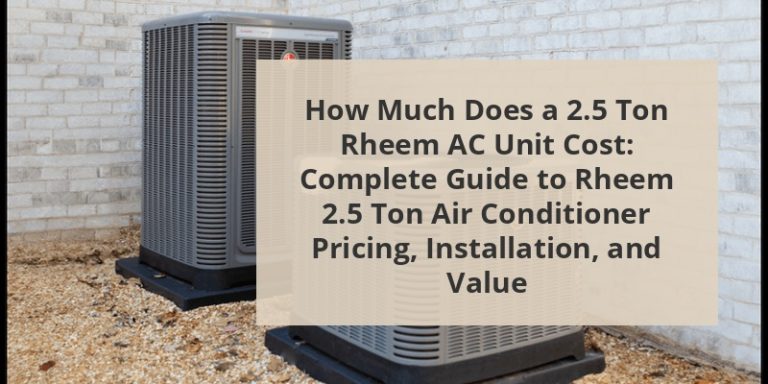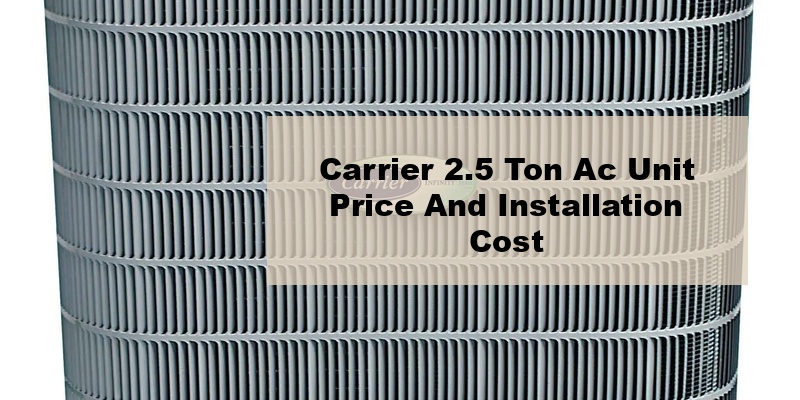Cost Of A 2.5 Ton Ac Unit

Understanding the cost of a 2.5-ton AC unit is crucial for homeowners, HVAC professionals, and employers alike. This article delves into the multifaceted aspects of pricing, installation, and long-term operational costs, while also exploring the career opportunities within the burgeoning HVAC industry.
The Price Breakdown: What to Expect for a 2.5-Ton AC Unit
When estimating the cost of a 2.5-ton AC unit, you're not just looking at the price tag of the equipment itself. Several factors influence the final expense:
- Unit Cost: The unit itself can range from $2,500 to $6,000 depending on the brand, SEER rating (Seasonal Energy Efficiency Ratio), and features. Higher SEER ratings translate to greater energy efficiency but also a higher initial cost. Brands like Carrier, Trane, and Lennox typically command premium prices, while Goodman and Rheem offer more budget-friendly options.
- Installation Costs: Labor is a significant component. Expect to pay between $1,500 and $4,000 for professional installation. This includes removing the old unit, installing the new one, connecting ductwork, electrical work, and refrigerant charging. Complex installations, such as those requiring ductwork modifications or electrical upgrades, will increase the price.
- Additional Components: Thermostats, condensate pumps, and upgraded ductwork are often necessary. Smart thermostats can add $100-$300, while ductwork repairs or modifications can range from a few hundred to several thousand dollars.
- Permits and Inspections: Local building codes often require permits for AC installations, adding $50-$200 to the overall cost. Inspections ensure the installation meets safety and code standards.
Therefore, the total cost of a 2.5-ton AC unit, including installation, can range from $4,000 to $10,000 or more. Obtaining multiple quotes from reputable HVAC contractors is essential to ensure a fair price.
Factors Influencing AC Unit Cost
Several factors can significantly impact the final cost of your 2.5-ton AC unit installation:
- SEER Rating: Higher SEER ratings mean greater energy efficiency, resulting in lower utility bills over the unit's lifespan. However, units with higher SEER ratings typically have a higher upfront cost. Consider the long-term savings when making your decision. The minimum SEER rating required by the Department of Energy (DOE) varies by region.
- Brand Reputation: Established brands like Carrier and Trane are known for their reliability and performance. While they may be more expensive, their longevity and performance can justify the higher price.
- Installation Complexity: Difficult installations, such as those requiring significant ductwork modifications or electrical upgrades, will increase labor costs.
- Location: Labor costs vary significantly depending on your geographic location. Areas with a higher cost of living will generally have higher installation costs.
- Contractor Expertise: Hiring a licensed and experienced HVAC contractor is crucial for a proper installation. While their rates might be higher than less experienced contractors, the quality of their work and their adherence to building codes will save you money in the long run.
Career Paths in the HVAC Industry: Opportunities and Certifications
The HVAC industry offers a wide range of career paths for individuals with various skill sets and experience levels. According to the Bureau of Labor Statistics, the job outlook for HVAC technicians is projected to grow 6 percent from 2022 to 2032, about as fast as the average for all occupations. About 38,000 openings for HVAC mechanics and installers are projected each year, on average, over the decade.
Entry-Level Positions
Entry-level positions, such as HVAC apprentices, typically involve assisting experienced technicians with installations, repairs, and maintenance. Apprenticeships provide on-the-job training and classroom instruction, leading to journeyman status. Starting salaries for apprentices typically range from $30,000 to $40,000 per year.
Experienced Technicians
Experienced HVAC technicians are responsible for diagnosing and repairing complex HVAC systems, as well as installing new equipment. They may specialize in residential, commercial, or industrial HVAC systems. The median annual wage for HVAC mechanics and installers was $59,620 in May 2023, according to the BLS. The best-paid 10 percent earned more than $84,910.
Specialized Roles
The HVAC industry also offers opportunities for specialization in areas such as:
- HVAC Design Engineers: Design and develop HVAC systems for buildings.
- HVAC Sales Engineers: Sell HVAC equipment and services to commercial and industrial clients.
- HVAC Project Managers: Oversee the installation and maintenance of HVAC systems on large-scale projects.
Essential Certifications for HVAC Professionals
Certifications are crucial for career advancement and demonstrate competency to employers and clients:
- EPA Section 608 Certification: Required by the Environmental Protection Agency (EPA) for technicians who handle refrigerants. This certification ensures that technicians understand proper refrigerant handling procedures and regulations to prevent ozone depletion.
- NATE Certification: The North American Technician Excellence (NATE) certification is a widely recognized industry credential that demonstrates a technician's knowledge and skills in specific HVAC areas.
- HVAC Excellence Certification: Another respected certification program that assesses technicians' technical knowledge and skills.
- State and Local Licenses: Many states and local jurisdictions require HVAC contractors to be licensed. Licensing requirements vary by location and may include passing an exam, completing apprenticeship hours, and obtaining insurance.
Example Career Path: A student begins with an apprenticeship, obtains their EPA 608 certification, and works towards NATE certification. After several years of experience, they might specialize in commercial refrigeration and pursue additional training in that area. This pathway can lead to roles as a lead technician, supervisor, or even starting their own HVAC business.
The Employer Perspective: Hiring and Retaining Skilled HVAC Technicians
For employers in the HVAC industry, attracting and retaining skilled technicians is a significant challenge. The demand for qualified HVAC professionals is high, and competition for talent is fierce. Employers must offer competitive salaries, benefits, and opportunities for professional development to attract and retain top talent.
Key Considerations for Employers:
- Competitive Compensation: Offer salaries that are competitive with industry standards and reflect the technician's experience and certifications.
- Benefits Package: Provide a comprehensive benefits package, including health insurance, paid time off, retirement plans, and continuing education opportunities.
- Training and Development: Invest in training and development programs to help technicians enhance their skills and stay up-to-date with the latest technologies.
- Career Advancement Opportunities: Provide opportunities for technicians to advance within the company, such as promotions to lead technician, supervisor, or management positions.
- Company Culture: Foster a positive and supportive work environment where technicians feel valued and appreciated.
Employers also benefit from sponsoring apprenticeships and partnering with vocational schools to develop a pipeline of skilled workers. Supporting certification programs like NATE and HVAC Excellence helps ensure that their technicians possess the knowledge and skills necessary to provide high-quality service.
Long-Term Cost Considerations: Energy Efficiency and Maintenance
The initial cost of a 2.5-ton AC unit is just one aspect of the overall expense. Long-term costs, such as energy consumption and maintenance, can significantly impact the total cost of ownership.
Energy Efficiency
Choosing a unit with a high SEER rating can significantly reduce energy consumption and lower utility bills. While these units may have a higher upfront cost, the long-term savings can often outweigh the initial investment. Regularly maintaining your AC unit, such as cleaning the coils and replacing air filters, can also improve energy efficiency.
Maintenance
Regular maintenance is crucial for extending the lifespan of your AC unit and preventing costly repairs. Schedule annual maintenance checkups with a qualified HVAC technician. These checkups should include:
- Cleaning the coils
- Checking refrigerant levels
- Inspecting electrical connections
- Lubricating moving parts
- Replacing air filters
Neglecting maintenance can lead to reduced efficiency, increased energy consumption, and premature system failure. A well-maintained AC unit can last 15-20 years, while a neglected unit may only last 10-12 years.
Conclusion: Investing in Quality and Expertise
The cost of a 2.5-ton AC unit is influenced by various factors, including the unit's SEER rating, brand reputation, installation complexity, and contractor expertise. While it may be tempting to opt for the cheapest option, investing in a high-quality unit and a professional installation can save you money in the long run. The HVAC industry provides robust career opportunities for those with the right training and certifications. For those looking to enter the field, emphasizing certifications like EPA 608 and NATE is a surefire strategy. For employers, attracting and retaining skilled technicians requires competitive compensation, comprehensive benefits, and opportunities for professional development. By understanding the cost considerations and investing in quality and expertise, homeowners, HVAC professionals, and employers can ensure a comfortable and efficient indoor environment.










